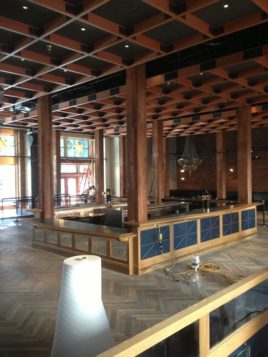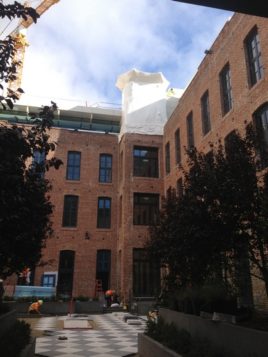BCCI Construction Company has recently completed the renovation of the historic 1907 Musto Building at 717 Battery St. in San Francisco, Calif. The 57,000-square-foot building, which is located near the northern edge of the North Beach neighborhood, has been converted into a private club.
The renovation of the existing three-story unreinforced masonry building — designed by early 20th-century architect William Mooser II — required a mandatory seismic upgrade and also included restoration work, basement expansion and the addition of a fourth floor penthouse to the L-shaped building, which for years featured a courtyard and entrance on Pacific Avenue. The new building extends the existing Battery Street façade, and a new façade on Pacific Street creates more of a presence. BCCI reused materials throughout the building, such as columns, beams and joists.
“The incorporation of a seismic strengthening system into the Musto Building’s historic fabric was a challenging process,” said BCCI Division Vice President Don Tiefenbrunn. “It required the complete excavation of the building’s footprint and foundation systems, meticulously removing, modifying and restoring visual elements to retain the original period structure.”
The existing site conditions were one of the first indications of a unique project. The geotechnical reports revealed a diverse soil and foundation for such a small footprint, in part because a third of the building was originally submerged in water. These extreme variances in soil condition informed the design of the foundation system, which is made up of steel micro-piles that support grade beams and new concrete pile caps encapsulate the original timber piles. In the end, BCCI was able to incorporate a seismic strengthening system that was sensitive to the building’s historic fabric by bracing it with three new frames that extend through each floor, allowing the interior brick surfaces — 80 percent of which is existing — to remain exposed.
Jim Williamson, field operations manager at BCCI Construction Company, said the most challenging aspects on working on the project were site logistics.
“Since Battery is a main artery that runs through the city, it can”t be shut down during the week and that limited our flexibility,” he said. “We had to hopscotch around with materials and manpower, and had to bring both in on an as-needed basis.”
He said another challenging aspect of the project included the installation of the moment frame. The team put in an elaborate shoring system and grabbed existing columns, as well as existing brick façade.
With the oversight of archaeologists Archeo-Tec, BCCI excavated the rock to provide new usable basement space. According to one of Archeo-Tec’s reports, the site’s natural topography had begun modification before the Gold Rush, when merchants and traders in Yerba Buena built wharves and platforms to make the town more accessible to ships. The excavation of 717 Battery resulted in several significant findings, some of which date back to the pre-Gold Rush era and relate to structures depicted on an 1848 map of Yerba Buena drawn by someone by the name of Captain Harrison. Archeo-Tec’s findings show that structural features include Thompson’s Wharf and Platform and an unanticipated deeply buried remnant of what appeared to be a wooden support for a building built over the shallows of the tidal zone of San Francisco Bay just east of dry land, a pre-Gold Rush planked road. Also found were a concentration of tools and other artifacts associated with the Thompson Hide Operation, a concentration of large adobe-like fired bricks, and 20 ceramic fragments of Chinese origin.
The new building located at the courtyard basement has grade beams overcast concrete piles and shotcrete perimeter walls. Among the array of materials used in the overall project, wood timber, much of it reused, is the most prominent throughout the building. Interior work includes exposed ceilings in many locations on the first floor to showcase the wood joist structural system that connects to the heavy wood timber beams and columns. Many of the windows have wood frames, and wood flooring makes up a third of the finishes. The exterior features a modern glass curtain structure at the penthouse level, which opens to the roof deck, and is a stark contrast to the brick masonry walls of the existing structure. To support the main building, BCCI built a standalone cast-in-place concrete block service building to house HVAC and boilers, which are screened by landscaping by MPA Design.
Communication and teamwork were key to overcoming all project challenges.
“We went to great lengths to make sure we were not inconveniencing the neighbors,” Williamson added. “We held very thorough construction meetings from conception to completion. We held weekly meetings with the architects and consultants, and daily meetings with subcontractors to ensure quality control and that the finished product would be done right.”
Project Team
BCCI, General Contractor
FME Architecture + Design, Core & Shell Architect
Ken Fulk, Interior Architect
Holmes Culley, Structural Engineer
MPA Design, Landscape Architect
Images courtesy of Kale Bruner.






 Join our thriving community of 70,000+ superintendents and trade professionals on LinkedIn!
Join our thriving community of 70,000+ superintendents and trade professionals on LinkedIn! Search our job board for your next opportunity, or post an opening within your company.
Search our job board for your next opportunity, or post an opening within your company. Subscribe to our monthly
Construction Superintendent eNewsletter and stay current.
Subscribe to our monthly
Construction Superintendent eNewsletter and stay current.